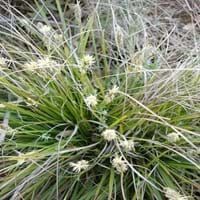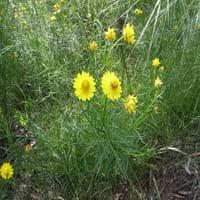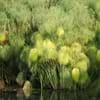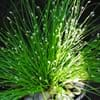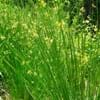Life Span
Perennial
Annual
Type
Sedge or Rush
Flowering Plants, Herbs
Types
Narrow sedge
Not Available
Habitat
Boggy areas, ditches, marshes, riparian zones, stream banks, Tropical regions, Wet forest
Terrestrial
USDA Hardiness Zone
6-9
10-11
Sunset Zone
3a, 3b, 4, 5, 6, 7, 8, 9, 14, 15, 16, 17, 18, 19, 20, 21, 22, 23, 24
21,22
Habit
Arching/Fountain-shaped
Cushion/Mound-forming
Flower Color
Brown
Orange, Gold
Flower Color Modifier
Bicolor
Bicolor
Fruit Color
Not Available
Non Fruiting Plant
Leaf Color in Spring
Dark Green, Light Yellow
Green, Dark Green
Leaf Color in Summer
Dark Green, Light Yellow
Green, Dark Green
Leaf Color in Fall
Dark Green, Light Yellow
Green, Dark Green
Leaf Color in Winter
Dark Green, Light Yellow
Light Green
Leaf Shape
Long Linear
Lobed
Plant Season
Spring, Summer, Fall, Winter
Summer, Fall
Sunlight
Partial Sun, Partial shade
Full Sun
Type of Soil
Clay, Loam, Sand
Loam
The pH of Soil
Acidic, Neutral, Alkaline
Neutral
Soil Drainage
Well drained
Well drained
Bloom Time
Spring
Spring, Late Spring, Early Summer, Summer, Late Summer, Early Fall, Fall, Late Fall
Tolerances
Drought, Heat Tolerance
Drought
Where to Plant?
Container, Ground, Pot
Container, Ground
How to Plant?
Seedlings
Seedlings
Plant Maintenance
Low
Low
Watering Requirements
Average Water Needs, Do Not over Water, Never Over-water, Prefer drip-irrigation instead of Over-head watering, Requires regular watering
Needs less watering
In Summer
Ample Water
Lots of watering
In Spring
Ample Water
Moderate
In Winter
Average Water
Average Water
Soil pH
Acidic, Neutral, Alkaline
Acidic
Soil Type
Clay, Loam, Sand
Well-aerated
Soil Drainage Capacity
Well drained
Loam, Well drained
Sun Exposure
Partial Sun, Partial shade
Full Sun
Pruning
Remove damaged leaves, Remove dead leaves
Remove damaged leaves, Remove dead branches, Remove dead leaves
Fertilizers
organic fertlizers, very little fertilizers at a time, Water soluble fertilizers
General garden fertilizer
Pests and Diseases
Aphids, Mealybugs, Red blotch, Scale, Slugs
Pests and diseases free
Plant Tolerance
Dry Conditions, Heat Tolerance
Drought, Heat Tolerance
Flowers
Insignificant
Showy
Flower Petal Number
Single
Single, Double
Foliage Texture
Fine
Medium
Foliage Sheen
Glossy
Matte
Attracts
Insects, Mealybugs
Not Available
Allergy
Asthma
no allergic reactions
Aesthetic Uses
Beautification, Borders, Cottage Garden, Landscape Designing, Showy Purposes
Showy Purposes, Water gardening
Beauty Benefits
No Beauty Benefits
Good for the Scalp, Removes dandruff, Stops hair loss
Environmental Uses
Air purification, Food for insects, Shelter for wildlife, Versatility, Wildlife
Air purification
Medicinal Uses
Diuretic
anti-allergy, anti-inflammatory, Antiseptic, Antispasmodic, Fungicidal
Part of Plant Used
Leaves
Flowers
Other Uses
Decoration Purposes, Showy Purposes, Used as Ornamental plant
Oil is used for aromatherapy, Used for its medicinal properties
Used As Indoor Plant
Yes
No
Used As Outdoor Plant
Yes
Yes
Garden Design
Container, Edging, Foundation, Groundcover, Mixed Border
Bog Garden, Lawns and Turf
Botanical Name
CAREX oshimensis 'Supergold'
XEROCHRYSUM bracteatum 'Copper'
Common Name
Sedge
Dreamtime Copper Strawflower, Strawflower
In Hindi
evergold Sedge
strawflower
In German
Evergold Segge
Strohblume
In French
Evergold carex
strawflower
In Spanish
Evergold juncia
strawflower
In Greek
evergold σπαθόχορτο
strawflower
In Portuguese
Evergold Sedge
strawflower
In Polish
Evergold turzyca
strawflower
In Latin
evergold Sedge
strawflower
Phylum
Tracheophyta
Magnoliophyta
Class
Liliopsida
Magnoliopsida
Family
Cyperaceae
Asteraceae
Clade
Angiosperms, Commelinids, Monocots
Angiosperms, Asterids, Eudicots
Tribe
Cariceae
Gnaphalieae
Subfamily
Cyperoideae
Asteroideae
Importance of Evergold Sedge and Strawflower
Want to have the most appropriate plant for your garden? You might want to know the importance of Evergold Sedge and Strawflower. Basically, these two plants vary in many aspects. Compare Evergold Sedge and Strawflower as they differ in many characteristics such as their life, care, benefits, facts, etc. Every gardener must at least have the slightest clue about the plants he wants to plant in his garden. Compare their benefits, which differ in many ways like facts and uses. The medicinal use of Evergold Sedge is Diuretic whereas of Strawflower is anti-allergy, anti-inflammatory, Antiseptic, Antispasmodic and Fungicidal. Evergold Sedge has beauty benefits as follows: No Beauty Benefits while Strawflower has beauty benefits as follows: No Beauty Benefits.
Compare Facts of Evergold Sedge vs Strawflower
How to choose the best garden plant for your garden depending upon its facts? Here garden plant comparison will help you to solve this query. Compare the facts of Evergold Sedge vs Strawflower and know which one to choose. As garden plants have benefits and other uses, allergy is also a major drawback of plants for some people. Allergic reactions of Evergold Sedge are Asthma whereas of Strawflower have no allergic reactions respectively. Having a fruit bearing plant in your garden can be a plus point of your garden. Evergold Sedge has no showy fruits and Strawflower has no showy fruits. Also Evergold Sedge is not flowering and Strawflower is not flowering . You can compare Evergold Sedge and Strawflower facts and facts of other plants too.
